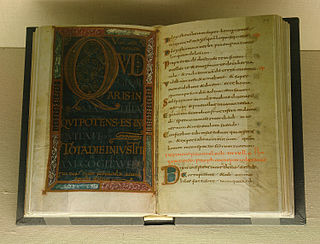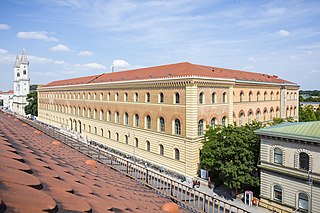
A psalter is a volume containing the Book of Psalms, often with other devotional material bound in as well, such as a liturgical calendar and litany of the Saints. Until the emergence of the book of hours in the Late Middle Ages, psalters were the books most widely owned by wealthy lay persons. They were commonly used for learning to read. Many Psalters were richly illuminated, and they include some of the most spectacular surviving examples of medieval book art.

A national library is a library established by a government as a country's preeminent repository of information. Unlike public libraries, these rarely allow citizens to borrow books. Often, they include numerous rare, valuable, or significant works. A national library is that library which has the duty of collecting and preserving the literature of the nation within and outside the country. Thus, national libraries are those libraries whose community is the nation at large. Examples include the British Library in London, and the Bibliothèque nationale de France in Paris.

The Bavarian State Library in Munich is the central "Landesbibliothek", i. e. the state library of the Free State of Bavaria, the biggest universal and research library in Germany and one of Europe's most important universal libraries. With its collections currently comprising around 10.89 million books, it ranks among the leading research libraries worldwide. The Bayerische Staatsbibliothek furthermore is Europe's second-largest journals library. Furthermore, its historical holdings encompass one of the most important manuscript collections of the world, the largest collection of incunabula worldwide, as well as numerous further important special collections. Its collection of historical prints before 1850 totals almost one million units.

TheNational Library of Russia, located in Saint Petersburg, is the first, and one of three national public libraries in Russia. The NLR is currently ranked among the world's major libraries. It has the second biggest library collection in the Russian Federation, a treasury of national heritage, and is the All-Russian Information, Research and Cultural Center. Over the course of its history, the library has aimed for comprehensive acquisition of the national printed output and has provided free access to its collections.

The Załuski Library established in Warsaw in 1747 by Józef Andrzej Załuski and his brother, Andrzej Stanisław Załuski, both Roman Catholic bishops, was a public library nationalized and renamed upon its founders' death into the Załuski Library of the Republic which existed until the final demise of Polish-Lithuanian Commonwealth in the Third Partition of Poland in 1795.

John Baptist Albertrandi was a Polish Jesuit, bishop and historian of Italian extraction, born in Warsaw.

Józef Andrzej Załuski was a Polish Catholic priest, Bishop of Kiev, a sponsor of learning and culture, and a renowned bibliophile. A member of the Polish nobility (szlachta), bearing the hereditary Junosza coat-of-arms, he is most famous as co-founder of the Załuski Library, one of the largest 18th-century book collections in the world.

Andrzej Stanisław Kostka Załuski was a priest (bishop) in the Polish–Lithuanian Commonwealth.

The Krasiński Palace, also known as the Palace of the Commonwealth, is a reconstructed Baroque palace in Warsaw, Poland, on Krasiński Square. Initially erected between 1677 and 1683 for the powerful Krasiński family, it was heavily damaged during World War II and rebuilt in the mid-20th century.

Jagiellonian Library is the library of the Jagiellonian University in Kraków and with almost 6.7 million volumes, one of the largest libraries in Poland, serving as a public library, university library and part of the Polish national library system. It has a large collection of medieval manuscripts, for example Copernicus' De Revolutionibus and Jan Długosz's Banderia Prutenorum, and a large collection of underground literature from the period of communist rule in Poland (1945–1989). The Jagiellonian also houses the Berlinka art collection, whose legal status is in dispute with Germany.

The destruction of Warsaw was Nazi Germany's razing of the city in late 1944, after the 1944 Warsaw Uprising of the Polish resistance. The uprising infuriated German leaders, who decided to destroy the city in retaliation.

The Codex Suprasliensis is a 10th-century Cyrillic literary monument, the largest extant Old Church Slavonic canon manuscript and the oldest Slavic literary work located in Poland. As of September 20, 2007, it is on UNESCO's Memory of the World list.

The Berlinka ('Berliner'), also depozyt berliński and skarb pruski, is the Polish name for a collection of German original manuscripts originally kept at the Prussian State Library in Berlin, which since the end of World War II are held by the Jagiellonian Library in Kraków. The legal status of the documents is subject of an ongoing debate.

The British Library is a research library in London that is the national library of the United Kingdom. It is one of the largest libraries in the world. It is estimated to contain between 170 and 200 million items from many countries. As a legal deposit library, the British Library receives copies of all books produced in the United Kingdom and Ireland, including a significant proportion of overseas titles distributed in the UK. The Library is a non-departmental public body sponsored by the Department for Culture, Media and Sport.

The University of Warsaw Library is a library of the University of Warsaw, Poland.

The Polish Library in Paris is a Polish cultural centre of national importance and is closely associated both with the historic Great Emigration of the Polish élite to Paris in the 19th-century and the formation in 1832 of the Literary Society, later the Historical and Literary Society. The Library was founded in 1838 by Adam Jerzy Czartoryski, Julian Ursyn Niemcewicz and Karol Sienkiewicz, among others. Its first task was to safeguard all surviving books, documents, archives and treasures of national significance. It has become a historical and documentary resource open for the use of Poles and other researchers and visitors. The Library houses three museums related to significant Polish artists: the Salon Frédéric Chopin, the Adam Mickiewicz Museum and the Bolesław Biegas Art collection. UNESCO's Memory of the World Register rates it as an institution unique of its kind.

The Sankt Florian Psalter or Saint Florian Psalter is a brightly illuminated trilingual manuscript psalter, written between late 14th and early 15th centuries in Latin, Polish and German. The Polish text is the oldest known translation of the Book of Psalms into that language. Its author, first owners, and place of origin are still not certain. It was named after St. Florian Monastery in Sankt Florian, a town in Austria, where it was discovered.

The Voivodeship and Municipal Public Library "Dr. Witold Bełza" in Bydgoszcz is housed in historical buildings located between the Stary Rynek and Długa street, registered on the Kuyavian-Pomeranian Voivodeship Heritage List. It is the oldest (1903) library in activity in the Kuyavian-Pomeranian Voivodeship. Since 2002, it bears the name of Witold Bełza.

Polona is a Polish digital library, which provides digitized books, magazines, graphics, maps, music, fliers and manuscripts from collections of the National Library of Poland and co-operating institutions. It began its operation in 2006.

Central Military Library (CBW) is the main library of Poland Ministry of National Defense located in Warsaw. In 2009, she was awarded the Gloria Artis Medal for Merit to Culture.
























